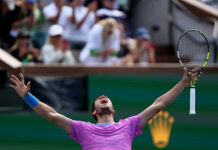By Bill Simons
Stan Wawrinka is a pretty conventional Euro guy—kind of a regular fellow, a humble Dad. But to knowing hipsters, street folks, and philosopher kings around the globe, he is No. 1 in the world.
After all, the Swiss trooper has the No. 1 tennis tattoo in the known universe. Come on, how cool are the immortal words of the late Irish poet Samuel Beckett? “Ever tried. Ever failed. No matter. Try again. Fail better.”
Fine, but there was a problem on the eve of the Australian Open final. Yes, the stadium was jammed. The photographers were packed in tight—lenses long. Flags were furling, the great Pete Sampras placed the shining trophy on its courtside pedestal, waiting to be claimed. The ball boys were primed, the linesmen grim and in place.
But something else was grim. The mood of fans and media alike was suspect, almost sullen. Grand Slam championships are supposed to be epic battles of two powerful, equally-matched titans. But tonight’s Aussie Open final promised to be little more than a drubbing.
After all, Rafa Nadal had, despite his injured hand, been blistering foes en route to the semis, where in straight sets, he’d swept aside the newly minted Roger Federer. Going back to last March, Nadal had proven again and again that he is a fearsome force on hard courts, whether they be in California, Canada, New York, or Down Under. His lead atop the rankings was monumental, almost embarrassing. Many were beginning to whisper:, “Wake up, tennis—lift the curtain, embrace reality, maybe that Spanish blaster is the best to ever play.” Such heresy—yes. But, then again, perhaps a reality.
In any case, Nadal would certainly win his second Aussie Open and become the first player of the Open Era to win the four majors at least twice.
The 27-year old had dominated Stan Wawrinka—the Swiss veteran with the sublime backhand and the perpetual (Federer-induced) inferiority complex—more than any other player on the tour. Not only would Wawrinka be playing his first ever Slam final (can you say u-p-t-i-g-h-t?), he would be facing a player he against whom he’d lost all 12 previous matches and all 26 previous sets.
Yes, three of the last four four sets they had played had gone to tiebreaks, and Wawrinka—who reached the US Open semis in September, and won in Chennai, India in January—was quietly trending upward.
And remember that anything in sports is possible. Joe Namath’s upstart Jets shocked the haughty Baltimore Colts. Back in 1990, boxing nobody Buster Douglas, knocked out then-dominant Mike Tyson.
Sure, some savants noted that Nadal’s last Grand Slam loss was at Wimbledon to Steve Darcis, who had a one-handed backhand, and added that Wawrinka’s backhand was flatter and better than Federer’s (which Nadal delights in breaking down). Plus, Wawrinka’s quiet Nordic coach, Magnus Norman, was the very same wizard who coached Robin Soderling, the player who’d dealt Rafa his sole devastating defeat at the French Open.
But around Rod Laver Arena, conventional wisdom was having none of this. Grasp for straws all you want, but everyone knew that history would repeat itself. It wasn’t that the Swiss guy, the No. 8 seed, would stink up the gym. He had just dismissed Novak Djokovic and Tomas Berdych. It was more that Rafa would simply again overpower him.
The final would be a hefty anti-climax. But, don’t be greedy. At least, we had our dose of sizzling matches before the final. Tonight our destiny was a fast, forgettable happening like the years finals Andre Agassi had with the likes of Ranier Schuettler or Arnaud Clement.
But a funny thing happened on the way to the Nadalian coronation. Wawrinka came out of the gates calm and focused: eager for the battle. He easily held serve in the opening game and soon took advantage of a Nadal brain-cramp drop shot to break Rafa’s serve and grab a 3-1 lead.
Go figure, something was happening here. What is was wasn’t exactly clear. Well, that is, until midway through the set at which point it became abundantly evident that Wawrinka—powerful and imposing—was serving well, taking the initiative, stepping in, creating angles, and leaving Rafa lunging on one point and flat-footed on the next. Wawrinka’s forehand scored a slew of winners, his backhand was sublime and unpredictable.
All the while, a boatload of predictions from the best and brightest in tennis were beginning to sink. As Rafa’s return faltered badly, Wawrinka scored six straight points to capture the critical opening set 6-3.
But things would soon implode. Wawrinka continued his stunning performance, breaking Nadal at love in the opening game, and then consolidating for 2-0. Then, Nadal suddenly reached for his back. He later explained, “The back, since the beginning I felt a little bit, from the warmup. It was a little bit worst in the first set. End of the first set, I start to feel worst. Then at the beginning of the second was the key moment that I felt, during a serve in a bad movement, is very stiff, very bad.”
In a moment, the contest pivoted. The man known for his muscular play, his movement and physicality, was suddenly hobbled. Walking gingerly, serving awkwardly, he took a long off-court medical time out. When the humble, charismatic, and often beloved athlete returned, a wounded warrior, many in the usually benign Aussie crowd booed him.
Astonishing! Okay, Rafa has been criticized for his slow play and grunting. And some say tennis players only get injured when they are losing. But, who would insist that the gracious champion was feigning injury?
Holding his face, seeming to tear up , he looked lost. Still, he was determined not to duplicate what Justine Henin had done in 2006, when she pulled out of the women’s final in Melbourne.
Rafa promptly dropped virtually all his usual timely and tedious on-court routines, and rolled in 70 MPH serves. He could barely move, and he lay down during changeovers to get intense massage.
All the while, a totally confused Wawrinka lost his winning rhythm.
Then, miracle of miracles, when trailing 1-5, it seemed as if Rafa’s painkillers kicked in, or somehow his back warmed to the task.
Wawrinka was now dealing with a bear coming out of hibernation. Nadal wasn’t his usual fierce self. But after dropping the second set 6-2, he positioned himself for a comeback against a baffled opponent who inexplicably now seemed adrift. Letting loose his power, moving with slightly more ease, and pressuring Wawrinka, Rafa broke early, then staved off break points later on to score a 6-3 third set win.
Match on. One presumed Nadal, the grinder and inspired game manager, would somehow figure a way to play through the pain.
But, without much ado, Wawrinka quietly regrouped and began to unleash the same punishing tennis seen in the opener, a set Stan later described as perfect. Nadal was back on the ropes as Wawrinka—his forehand flashing—broke to go up 4-2, just two games from the championship. Then nerves kicked in, and a string of mistakes by Wawrinka allowed Nadal to break back. But Stan rebounded, forcing a critical volley error from Nadal and scoring yet another break. One game to go. His heart pumping, Wawrinka powered three service winners and a forehand winner to score one of the most inexplicable, unpredictable, and heartwarming Grand Slam triumphs.
A Swiss man not named Roger, had prevailed. Incredibly, for the first time since Juan Martin del Potro won the US Open in 2009, someone other than Federer, Nadal, Djokovic, and Murray had claimed a Slam. Wawrinka was the first player to have beaten both Djokovic and Nadal in a Slam, the first to have beaten the No. 1 and No. 2 seeds in a Slam in over 20 years, and the first No. 8 seed to win the Aussie Open since Brian Teacher in 1980.
The man who came into the tournament No. 8 in the world was now No. 3, the highest ranked Swiss player on the planet. Now—and this certainly doesn’t feel right—Federer is No. 8.
Nadal was supposed to have tied Sampras’ mark of 14 majors. Instead, Sampras gave the trophy to Stan.
Moments later, in his post-match press conference, Nadal was subsumed with sadness. For the fourth time in five years at the Aussie Open, physical woes had done him in: in 2010, a knee injury vs. Andy Murray; in 2011, a pulled hamstring vs. David Ferrer; in 2013, sidelined by a knee; and now his back.
We asked Rafa what he thought about all of his Down Under woes. Was it just sport, or a coincidence?
Rafa explained, “You know what, is true … I was not very lucky … This is a tournament that is painful for me. Is a tournament that I love so much … a tournament that I feel the conditions are good for me, warm conditions that I like, good crowd … So, yeah, is a tournament that I really had some troubles physically in my career, and is something that is painful … But that’s part of life, part of sport. Is not the end of the world. Is just another tough moment. Is not the first.
I feel very lucky that I was able to enjoy much more happy moments than tough moments. At the end, [tennis] is a sport of victories. People remember the victories …
For me is a tough one tonight, because I felt that I was ready to compete well. But … I’m going to keep enjoying … I feel very lucky to be able to work in something that I really love. Not everybody’s able to do that. Nothing wrong. Just bad day, tough day.”
Tough day, you say—yes. But certainly Stan Wawrinka has suffered a kazillion more wretched days than the mighty Nadal. That’s why Stan which has that ode to persistence on his arm, that Beckett tattoo, “Ever tried. Ever failed. No matter. Try again. Fail better.”
Wawrinka explained, “I did a tattoo only one year ago. I had that quote in my head for a long time. It was part of my life, how I see the life, and especially how I see the tennis life.
Before today, I was always saying [to myself] that except Roger, Rafa, Novak, you always lose, especially every week. It’s not easy, because in the tennis life, when you lose, it’s tough to get through and to take a positive from a loss, from failing …
So that’s how I see my career. I always go back to the court, back to practice to improve, and to give me all the chances to beat the best.”
Tonight, the player they call Stan the Man surprised himself with how well he played. He surprised Rafa, who was expecting to lift his 14th Slam trophy. And he surprised the sages of the tennis world, who were expecting a stinker, but instead got a shocker for the ages.



















